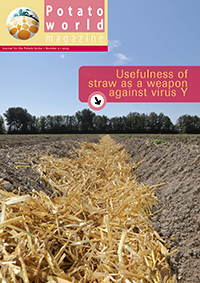Already a subscriber? Activate your premium account

Potatoworld Magazine

Well over thirty years ago when I worked for the International Potato Center – CIP – at the national potato improvement program in Rwanda we tried a then new technique: true potato seed. CIP showed in its annual report a small boy sitting on a big pile – two tons – of forty bags of fifty kg seed tubers, enough to plant one hectare of potatoes.
Some forty thousand seed tubers weighing fifty grams each. In one hand the boy held a jar containing potato seeds, true potato seeds: TPS. CIP hoped to be able to replace conventional seed tubers by TPS. Imagine to save 2 tons of potatoes for food, no need to store, to sprout, to transport. Added huge advantage is that most of the common seed borne diseases such as viruses and bacteria are not transmitted by seed. The big advantage of planting two tons of seed, a real investment that they emerge faster, quickly form lots of leaves that intercept sunlight and make the plant grow. It is like putting money on the bank: a larger sum yields a larger amount of interest. The small potato seeds took too much time to produce a crop and yields were not high enough. Sowing seeds in a nursery and using the progeny – minitubers – as the start of a seed program did not become a success either because seed from self pollination suffered from inbreeding but even progeny seed tubers of seed from crosses (F1) yielded less than the parents because many plants showed unfavorable characteristics. That is the reason why in a potato breeding program only one variety emerges out of many tens of thousands of seedlings. This because each gene in potato is present four times – and not always dominant – so the good trait it produces does not always show.

A company at Wageningen, Solynta headed by dr. Pim Lindhout, produces potato plants that have only two sets of chromosomes (diploid) rather than four so it is much easier to arrive at plants that have the desired trait, especially if the plant forms berries and seed after it pollinates itself. Therefore first a cross had to be made with a wild species that contains a gene (Sli) allowing diploid plants to forms seeds which normally they do not do. After repeating this inbreeding process a few times all genes for the undesired traits are gone and the genes for the desired trait are dominant on each of the two chromosomes: homozygous. These parent lines – created in the same way as e.g. cucumber and sugar beets – are then crossed to create F1 hybrids which are known for their vigor. The advantage of homozygous lines is that they can be used to introduce new traits by crossing and backcrossing. In this way, hybrid cultivars can easily be improved by adding new traits without changing most of the genetic composition. This can be achieved in two to three years. This makes breeding much more science based and faster. For instance, to introduce four resistance genes to Phytophthera infestans into an existing variety may take three to four years only.
In contrast, traditional potato breeding is based on the cross between two cultivars that have four sets of different chromosomes. The progenies have a random combination of traits of both parents. It takes five years of selection to identify the best progeny plant with the optimal set of chromosomes. For each cross this multiyear evaluation is repeated and hence breeding takes long. For instance, to introduce four resistance genes to Phytophthera infestans into a new variety may take 25 to 40 years. Solynta has overcome the inbreeding depression in potato and will develop the first homozygous good performing elite clone in 2012. The first commercial hybrid is expected in 2015.
So after some thirty-five years the dream of Richard Sawyer – founder of CIP – to replace seed potatoes with TPS may become a reality. As added benefit to the freedom of diseases, the method allows a quick inclusion of desired traits such as disease resistance. Rather than transporting huge amounts of seed potatoes, jars of seeds are sent that each produce identical plants that will produce identical seedling tubers to be used for further multiplication. The figure shows a Solynta F1 hybrid cultivar producing minitubers.
Anton Haverkort
anton.haverkort@wur.nl
Events
©2015 - 2024 Potatoworld | Webdesign and realisation COMMPRO